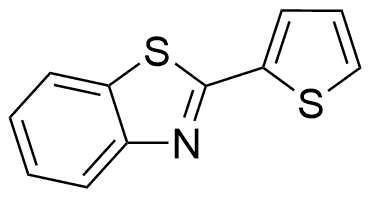2-(2-Thienyl)benzothiazole is widely utilized in research focused on:
- Organic Electronics: This compound is used in the development of organic semiconductors, which are crucial for creating flexible and lightweight electronic devices such as OLEDs (Organic Light Emitting Diodes).
- Pharmaceuticals: It serves as a building block in the synthesis of various pharmaceutical agents, particularly those targeting cancer and infectious diseases, enhancing drug efficacy and specificity.
- Material Science: The compound is incorporated into polymers to improve their thermal and electrical properties, making them suitable for advanced applications in coatings and composites.
- Fluorescent Probes: It is utilized in the design of fluorescent probes for biological imaging, allowing researchers to visualize cellular processes with high precision and clarity.
- Agrochemicals: This chemical plays a role in the formulation of agrochemicals, contributing to the development of more effective pesticides and herbicides that are environmentally friendly.
General Information
Properties
Safety and Regulations
Applications
2-(2-Thienyl)benzothiazole is widely utilized in research focused on:
- Organic Electronics: This compound is used in the development of organic semiconductors, which are crucial for creating flexible and lightweight electronic devices such as OLEDs (Organic Light Emitting Diodes).
- Pharmaceuticals: It serves as a building block in the synthesis of various pharmaceutical agents, particularly those targeting cancer and infectious diseases, enhancing drug efficacy and specificity.
- Material Science: The compound is incorporated into polymers to improve their thermal and electrical properties, making them suitable for advanced applications in coatings and composites.
- Fluorescent Probes: It is utilized in the design of fluorescent probes for biological imaging, allowing researchers to visualize cellular processes with high precision and clarity.
- Agrochemicals: This chemical plays a role in the formulation of agrochemicals, contributing to the development of more effective pesticides and herbicides that are environmentally friendly.
Documents
Safety Data Sheets (SDS)
The SDS provides comprehensive safety information on handling, storage, and disposal of the product.
Product Specification (PS)
The PS provides a comprehensive breakdown of the product’s properties, including chemical composition, physical state, purity, and storage requirements. It also details acceptable quality ranges and the product's intended applications.
Certificates of Analysis (COA)
Search for Certificates of Analysis (COA) by entering the products Lot Number. Lot and Batch Numbers can be found on a product’s label following the words ‘Lot’ or ‘Batch’.
Numéro de catalogue
Numéro de lot/série
Certificates Of Origin (COO)
This COO confirms the country where the product was manufactured, and also details the materials and components used in it and whether it is derived from natural, synthetic, or other specific sources. This certificate may be required for customs, trade, and regulatory compliance.
Numéro de catalogue
Numéro de lot/série
Safety Data Sheets (SDS)
The SDS provides comprehensive safety information on handling, storage, and disposal of the product.
DownloadProduct Specification (PS)
The PS provides a comprehensive breakdown of the product’s properties, including chemical composition, physical state, purity, and storage requirements. It also details acceptable quality ranges and the product's intended applications.
DownloadCertificates of Analysis (COA)
Search for Certificates of Analysis (COA) by entering the products Lot Number. Lot and Batch Numbers can be found on a product’s label following the words ‘Lot’ or ‘Batch’.
Numéro de catalogue
Numéro de lot/série
Certificates Of Origin (COO)
This COO confirms the country where the product was manufactured, and also details the materials and components used in it and whether it is derived from natural, synthetic, or other specific sources. This certificate may be required for customs, trade, and regulatory compliance.


